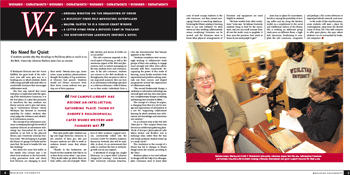No Need For Quiet
 If students wonder why they should go to the library when so much is on the Web, University Librarian Barbara Jones has an answer.
If students wonder why they should go to the library when so much is on the Web, University Librarian Barbara Jones has an answer.
If Wesleyan’s librarian sees her vision fulfilled, the quiet hush of the reference area will soon give way to a bustling area in which students clutch coffee mugs and talk with each other in comfortable furniture that encourages collaborative work.
The first step toward that vision took place in September with the opening of the Information Commons. It is the first phase of a plan that promises to transform the way students use library services and to give real meaning to “information literacy,” which Wesleyan has deemed an essential capability for today’s students who must judge the relevance and reliability of information sources.
The concept of an information commons is sweeping through the world of academic libraries as information technology has diminished the need for students to set foot in the physical library, says University Librarian Barbara Jones. “We are hoping to re-people the library. It’s going to be lively and we want that. We want to breathe life into this building.”
Her desire for more foot traffic in the stately Olin Library says a lot about how students in the born-with-a-chip generation work and about how libraries are changing to meet their needs. Twenty years ago, Jones notes, many academic administrators thought the heyday of big institutional libraries had passed. Students would use library resources from their dorm rooms without ever getting out of their pajamas.
They were partly right. Students can tap into huge electronic resources in the comfort of their pj’s. But just because students are able to work in isolation doesn’t mean they always want to.
“Thanks to the bookstores, we found out that students don’t like to sit in their dorm rooms alone,” says Jones. “They would rather go where there are food, coffee, and a lot of people. That’s why Borders and Barnes & Noble are so successful.”
The info commons responds to the social aspect of learning, as well as the enormous impact of the Web and phenomena such as instant messaging on the way students learn and communicate. In the info commons, students can connect to the Web wirelessly or through ports; they can print in color or use map-sized scanners; they can turn to an information technology specialist or a reference librariana??both of whom are in their midst. Individuals from a host of other academic support services, conveniently rolled into the acronym SARN for Student Academic Resources Network, also will be available. In short, it’s an environment that seeks to combine the best in technology with one-on-one support.
A whirlwind of change has caught librarians. In a report titled “Libraries Designed for Learning,” Scott Bennett, Yale University Librarian Emeritus, cites two discontinuities that became apparent in the 1990s:
“Students everywhere were increasingly working in collaborative study groups of their own making, to engage more strongly and often more adventurously with their coursework. Recognizing the power of this mode of learning, many faculty members built experiential and problem solving materials into their courses and shaped assignments around the expectations of collaborative study.
“The second fundamental change, a revolution in information technology, was not at all quiet and was even more pervasive. Complementary changes in teaching and learning were not slow to follow.”
The concept of a library, he argues, is changing from that of a site for storage and organization of information to a site for “supporting collaborative learning by which students turn information into knowledge and sometimes into wisdom.”
Or, as a feature story in the New York Times put it: “The campus library has become an intellectual gathering place. Think of Europe’s philosophical caf??s where writers and thinkers met to exchange ideas rather than the wan and lonely graduate student holed up in a study carrel.”
This revolution in the concept of a library has led to changes in library design across the country, according to the Times.
Wesleyan plans to test and evaluate its design with the help of an ethnographer. Librarians want to know what sorts of work occupy students in the info commons. Are they instant messaging friends or searching databases, browsing the library catalog or learning how to use new software? To what extent are they working collaboratively versus socializing? Furniture can be moved, and the librarians want to know what physical arrangements of furniture and equipment are most helpful to students.
“We have models from other institutions,” Jones says. “At Indiana University students bring in food for the microwave, and you can smell cuisines from all over the world, curry to spaghetti. It does raise the question: how much at home do you want people to get?”
Jones has no plans for microwaves, but she is eyeing the possibility of serving coffee and tea along the Borders model, as a complement to the social and intellectual culture of the library. She is working on additional group study areas on different floors, a high-tech classroom, fundraising to complete the info commons, computers and perhaps a flat screen television to expand periodicals research, and more.
In the midst of this transformation, some students still want a place for contemplation, away from the decibel count of dorm life. Olin will continue to offer quiet places, she says, where students can sit surrounded by books, not computers.
